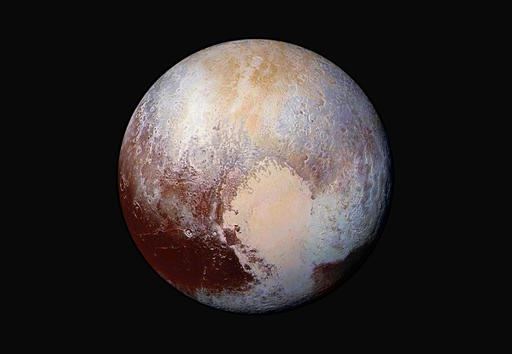ICY BASIN IN PLUTO'S HEART
MAY BE NATURAL SINKHOLE
by MARCIA DUNN, AP Aerospace Writer
 |
| This image made available by NASA on July 24, 2015 shows a combination of images captured by the New Horizons spacecraft with enhanced colors to show differences in the composition and texture of Pluto's surface. The deep icy basin in Pluto's heart-shaped region may be a natural sinkhole. In a study published Wednesday, Nov. 30, 2016, a team led by University of Maryland astronomer Douglas Hamilton suggests the basin may have resulted from the weight of surface ice. (NASA/JHUAPL/SwRI via AP) |
CAPE CANAVERAL, Fla. (AP) — The deep icy basin in Pluto's heart-shaped region may be a natural sinkhole.
In a study published Wednesday, a team led by University of Maryland astronomer Douglas Hamilton suggests the basin may have resulted from the weight of surface ice.
Computer modeling by the researchers indicates an ice cap formed at that location early in Pluto's history. All that ice may have caused the underlying crust to slump, creating the 600-mile-wide basin in the left lobe of the heart, now called Sputnik Planitia. Other models point to a crater caused by an impact.
"Pluto's big heart weighs heavily on the small planet, leading inevitably to depression," Hamilton said in a statement. He noted that the Greenland Ice Sheet on Earth created a basin in similar manner.
NASA's New Horizons spacecraft unveiled Pluto during last year's historic flyby.
Two weeks ago, another study in the same journal, Nature, suggested an ocean beneath Sputnik Planitia, named after Earth's first man-made satellite. Hamilton said that still could be the case.
"While we cannot conclude definitively that there is an ocean under Pluto's icy shell, we also cannot state that there is not one," Hamilton said.
Launched in 2006, New Horizons is now more than 374 million miles from Pluto and enroute to another much smaller object in the so-called Kuiper Belt on the frozen fringes of the solar system; that close encounter is set for 2019. Mission Control is located at Johns Hopkins University.
Copyright 2016 The Associated Press. All rights reserved.
This material may not be published, broadcast, rewritten or redistributed.
Page created on 12/2/2016 2:05:22 AM
Last edited 12/2/2016 2:05:22 AM
The beliefs, viewpoints and opinions expressed in this hero submission on the website are those of the author and do not necessarily reflect the beliefs, viewpoints and opinions of The MY HERO Project and its staff.


